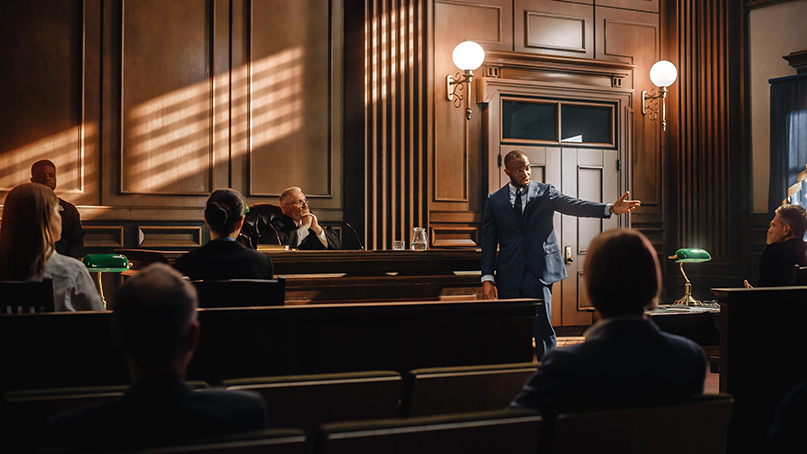Great legal movies and shows often feature the stirring oratory skills of impressive courtroom advocates – the sorts of lawyers who keep a jury hanging on their every word. But crafting a great opening statement is about more than brushing up on your rhetorical devices and practicing your delivery. Just as much as the opening needs to engage the jury and capture their attention, it needs to accomplish several functional goals as well. At the beginning of a trial, the jurors know nothing about your case other than they are going to spend days or weeks of their life listening to the lawyers and witnesses in the courtroom. The opening should help them make sense of what they’re about to hear.
What the Opening Needs to Accomplish
The opening is a chance to give the jury a roadmap to the evidence they are going to receive. Why is this so important? Because a good lawyer turns a trial into a story, but it’s a story she will not be able to tell precisely the way she wants. An attorney only has control over her half of the case. She cannot make the other side put on its witnesses in the order she wants or introduce the evidence in a manner consistent with her plan. For every great witness she puts on the stand who will make important points, the other side is going to try to undermine that testimony by making it seem confusing, minor, irrelevant, untrustworthy, or contradicted by other evidence. And just as she will be advancing her client’s narrative of the case and themes, the other side’s attorney will be trying to prove their own version of events. With the two sides competing to establish their own narratives, it is difficult, if not impossible, to present the jury with a story the way we are all used to hearing it, with a beginning, middle, and end.
A great opening is an excellent way to help the jury overcome the challenges inherent in how evidence is introduced at trial. The opening is a lawyer’s opportunity to present the evidence in manner that forms a coherent narrative. He can walk the jury through exactly what he expects to prove at trial, can highlight the key evidence the jury needs to focus on, and identify the important witnesses and their roles in the case.
Creating a Great Opening
To be effective, the opening must be clear, well-structured, and comprehensive. A visual presentation, embedding audio, video, images, and important documents can help keep the jurors engaged with the presentation and will familiarize them with what they can anticipate seeing over the course of the trial. A great opening will make the jury feel like active participants in solving a problem, rather than a passive audience. They will be empowered to use their reason, logic, and common sense to resolve difficult issues.
Attorneys can include in their opening any evidence they have a good faith basis to believe will be admitted at trial. The opening is a great chance to use deposition clips or excerpts to explain what witnesses are expected to say at trial, familiarizing the jury with trial’s “cast of characters.” It’s important, however, to be cautious about evidence the attorney knows is subject to a valid objection and is unlikely to be admitted. You might think the opening is a good way to get evidence in front of the jury that might not otherwise come in at trial, but you can be sure the other side’s lawyer will use their closing to point to the things your attorney promised in her opening that she would prove, but that was never admitted. This can seriously hurt your attorney’s credibility, and, by extension, the credibility of your case.
And while an opening statement must not be argumentative (it needs to be based on the facts and the evidence, not your lawyer’s efforts to characterize the evidence or make persuasive arguments), the opening is the right place to introduce your jurors to the themes you want them to keep in mind. Themes will help the jurors make sense of the relative importance of the different pieces of evidence; they help the jurors mentally organize what they are going to hear during the trial and understand where each piece of evidence fits into the broader story of your case.
A skilled trial attorney will also use the rhetorical devices of primacy and recency effectively in the opening. When presented with information, audiences place more focus and therefore importance on the first and last things they hear. An opening that begins powerfully and ends powerfully will stick with your jurors. But, even more than that, the opening is part of the overall storytelling your lawyer should engage in during the trial. In a speech, speakers are encouraged to structure their remarks into an introduction, evidence, then conclusion. In other words, “tell the audience what you’re going to tell them, tell them, then tell them what you told them.” In the same fashion, the opening is the introduction to the trial. It’s where your attorney tells the audience what all the witnesses and evidence are going to demonstrate for the jurors over the entire course of the proceedings. When you get to the closing, if your attorney can confidently show the jury that what he promised them in the opening is what he delivered, the jurors will feel more confident in deciding in your favor.
Conclusion
Great lawyers have spent years perfecting the techniques and strategies that create effective openings. Our teams of expert trial attorneys have honed these skills over hundreds of trials across a broad range of cases, from white collar criminal matters to complex commercial trials to intellectual property litigation. We have a breadth and depth of experience other firms simply cannot match. And we stand ready to help you achieve great results in your toughest cases.

